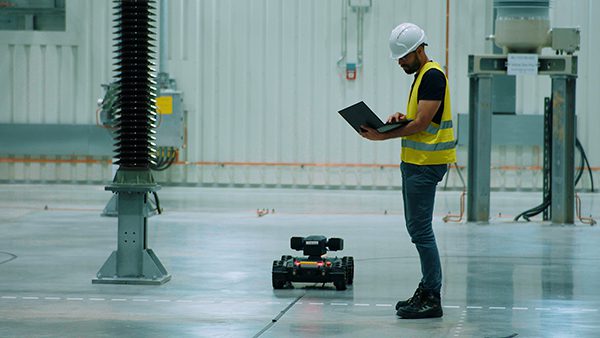During the annual maintenance week, an autonomous robot was installed in Elia’s high-voltage converter hall in Lixhe. The hall was then re-energized and inaccessible for the remainder of the year. The robot continuously inspects the converter hall, reducing the risk of undetected defects and unplanned stoppages.
The installation and use of the robot is the result of a two-year collaboration between Elia Group, Siemens Energy, Ross Robotics and Nemo Link. An extensive research and development phase with many tests under difficult working conditions was required. The ALEGrO robot is the first robot in Europe to perform automated frequent inspections of a HVDC (high-voltage direct current) hall. The robot works autonomously, but can also be remotely controlled. This ensures that the converter hall is inspected without interrupting the power supply.
Limit downtime
Elia reports in a press release that the robot has smart sensors that help identify potential problems in the hall at the Belgian-Dutch border. This reduces the risk of unexpected interruptions and shortens the time required for ad hoc recovery. In addition, the uptime of the converter hall is maximized and the robot ensures that the electricity exchange between Belgium and Germany can take place without interruption.
The robot’s sensors include an RGB camera, a thermal imaging camera, a pan-tilt element that carries the cameras, an audio sensor, a microphone, and a range of environmental sensors. These monitor the conditions in the hall, such as temperature, relative humidity and lighting. Two years ago, the partners started developing autonomous robots with electromagnetic compatibility (EMC) that can be used in a converter hall.
More robots are coming
The robot used in ALEGrO’s converter hall is a modified version of a robot originally developed by Ross Robotics. Siemens brought its expertise in the development of electronic components to the project. Another robot will soon be installed and commissioned in the converter hall of Nemo Link (the link between Belgium and Great Britain). In 2024, a third robot will be installed in a 50Hertz converter hall in Germany.
“The robot has many advantages. First and foremost, it allows for the continuous monitoring of assets so that their condition is checked and we are quickly notified when we need to take action or carry out preventative maintenance. The second benefit is that we can spot any anomaly in one of our assets and remotely control the robot to see exactly what is going wrong,” says Mark Vaes, Asset Manager at Elia.
